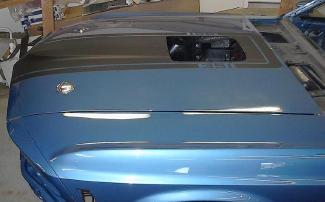Originally posted by Hemikiller:
Here's some of the the facts, Jack. 1970, 351C-4V was introduced as an M-code. 300hp, closed chamber heads, 2 bolt main caps,
cast flat top pistons for a 10.7:1 compression ratio, non adjustable hydraulic valvetrain,
Autolite 4300 square bore carb, dual exhaust. All automatics received the FMX.
1971, M-code continued unchanged, but was rated at 285 for some reason. Probably to be
second fiddle to the as-then planned 71 Mustang Boss 302 (290hp). The Boss 302 was dropped (thank god) in
favor of the 330hp Boss 351 (R-code). Automatic M-codes received the C-6 trans standard, with a poorly suited torque converter.
R- code (Mustang only) Boss 351 engine was only available in the sportsroofed Boss 351 model, 4-bolt main block, specially selected
crank, D1ZX rods of 1041 steel and 180,000 psi rod bolts, closed chamber heads with fully adjustable
valvetrain with mechanical cam (290 duration, .477 lift), Boss 302 type aluminum valve covers with "Boss 351"
emblem, dual point dizzy, forged pop-up (domed) pistons, larger (2.5" IIRC) exhaust
manifold outlets, aluminum spread bore intake with an Autolite 4300D carb, baffled oil pan with a crank scraper and a re-calibrated
dipstick to show 6-quart capacity as full and ram-air, F60-15 tires, wide ratio 4-speed and 3.91 gears as standard.
351CJ (280hp) was introduced in May '71. It was always VIN code "Q", never M. 351CJ was a 4-bolt main block. Pistons were the
same cast flat tops as the "M" code. Heads were identical to the M code --except-- that they used an open
combustion chamber design like the 351C-2V, reducing compression to around 9:1. Cam was a CJ specific grind, with a split duration
and lift (IIRC it was 280/290 duration, .480/.490 lift). 4-bolt main block, dual advance, dual point distributor was standard, oil capacity was 5 quarts, pan had a slosh plate over the sump. Intake was
cast iron with a Ford style spreadbore pattern, Autolite 4300D carb. Exhaust manifold outlets were smaller than Boss at 2 1/4", but larger than M's 2" outlets. All CJ's equipped
with an automatic got a C-6 with a special hi-stall torque converter (@ 2500rpms).
1972, M-code was gone. Q-code CJ continued essentially unchanged, but was now rated at 266 hp, due to the change
from Gross horsepower ratings to SAE Net horsepower ratings. Only other change was to retard the cam 4 degrees for
emissions purposes (this was apparently a corporate wide thing, all engines received this mod). The Mustang-only R-code was back
for a second year, but was now known as the 351HO. It was no longer a specific model, it was just a drivetrain option.
Heads on the HO now had the open chamber design, cam was still mechanical, but now had 275 duration and .490 lift.
1973, R-code was gone, Q-code received dished pistons to drop the compression even further. Emissions equipment sprouted from the motor, EGR, spark timing etc. Horsepower was now rated at 264.
At some time in the 73 model year, the CJ's received smaller valves in the heads. Valve sizes went from 2.19 I / 1.77" E to
2.05" I / 1.66" E, same as the 2V 351C.
1974, Q-code continued on in the Torino. By this time, it was so emasculated by emissions equipment (EGR, TRS, etc) that I don't wanna got here.















